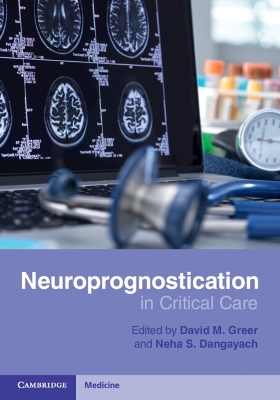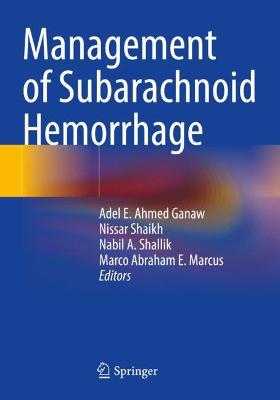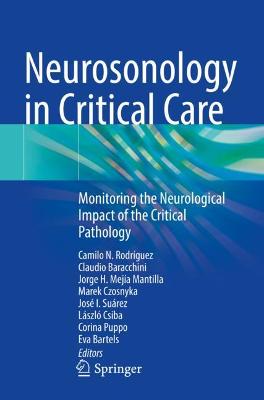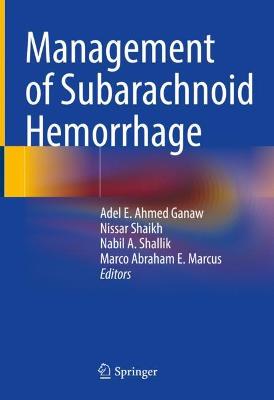Intracranial Pressure and Neuromonitoring XVII
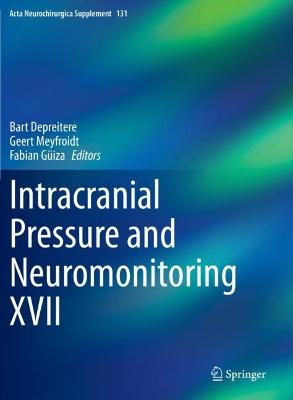 portes grátis
portes grátis
Intracranial Pressure and Neuromonitoring XVII
Depreitere, Bart; Gueiza, Fabian; Meyfroidt, Geert
Springer Nature Switzerland AG
04/2022
372
Mole
Inglês
9783030594381
15 a 20 dias
963
Descrição não disponível.
PART I ~ NEUROMONITORING AND MANAGEMENT IN ADULT TRAUMATIC BRAIN INJURY 1 ~ 1129 Microcirculatory Biomarkers of Secondary Cerebral Ischemia at Traumatic Brain Injury.- 2 ~ 1165 Visualisation of ICP Insults After Severe TBI; Influence of Individualised Limits of Reactivity.- 3 ~ 1178 Pressure Challenge Impact on Cerebral Critical Closing Pressure and Effective CPP in Traumatic Brain Injury Patients.- 4 ~ 1204 Semi-automated CT Volumetry as Proxy for Intracranial Pressure in Patients with Severe Traumatic Brain Injury: Clinical Feasibility Study.- 5 ~ 1224 The Error and Consequences of Inaccurate Estimation of Mean Blood Flow Velocity in Cerebral Arteries.- 6 ~ 1235 Analysis of Association Between Lung Function and Brain Tissue Oxygen Tension in Severe Traumatic Brain Injury.- 7 ~ 1246 A Comparison of Two ICP Calculation Methods and Their Effects on Mean-ICP and ICP Dose.- 8 ~ 1263 External Hydrocephalus After Traumatic Brain Injury: Retrospective Study of 102 Patients.- 9 ~ 1288 Analyzing Cardio-Cerebral Crosstalks in an Adult Cohort from CENTER-TBI.- 10 ~ 1308 Cerebrovascular Consequences of Elevated Intracranial Pressure After Traumatic Brain Injury.- PART II ~ NEUROMONITORING AND MANAGEMENT IN ADULT NON-TRAUMATIC BRAIN INJURY 11 ~ 1130 The Assessment of Cerebral Autoregulation in the Perifocal Zone of a Chronic Subdural Hematoma.- 12 ~ 1210 Noninvasive Intracranial Pressure Monitoring in Chronic Stroke Patients with Sedentary Behavior - Pilot Study.- 13 ~ 1291 Investigating Changes in Intracranial Pressure Waveform Morphology in Patients with Ventriculitis Using Clustering.- 14 ~ 1292 Perioperative Dynamics of Intracranial B-waves of Blood Flow Velocity in Basal Cerebral Arteries in Patients with Brain Arteriovenous Malformation.- PART III ~ NEUROMONITORING AND MANAGEMENT IN ADULT MIXED BRAIN INJURY POPULATIONS 15 ~ 1139 The Effect of Hyperthermia on the Intracranial Pressure and Cerebral Autoregulation in Patients with Acute Brain Injury.- 16 ~ 1194 A Comparative Study on the Effect of Early Versus Late Cranioplasty in Cognitive Function.- 17 ~ 1195 Effect of Cranioplasty After Decompressive Craniectomy in Traumatic Versus Non Traumatic Brain Injury on Neurological Function and Cerebral Hemodynamics.- 18 ~ 1221 Brain Multimodal Monitoring in Severe Acute Brain Injury: Is It Relevant for Outcome and Mortality?.- 19 ~ 1239 Long-term Outcome After Decompressive Craniectomy in a Developing Country.- 20 ~ 1357 Predictors of Successful Extubation in Neurocritical Patients.- PART IV ~ NEUROMONITORING AND MANAGEMENT IN THE PEDIATRIC POPULATION 21 ~ 1160 Impaired Autoregulation Following Resuscitation Correlates to Outcome in Pediatric Patients: A Pilot Study.- 22 ~ 1171 Brain Biomarkers in Children After Mild and Severe Brain Traumatic Injury.- 23 ~ 1200 Decompressive Craniectomy for Traumatic Intracranial Hypertension in Children.- 24 ~ 1214 The Use of Direct ICP and Brain Tissue Oxygen Monitoring in the Perioperative Management of Patients with Moyamoya Disease.- PART V ~ NEUROMONITORING TECHNOLOGY 25 ~ 1118 Optic Nerve Sheath Diameter Threshold for Increased Intracranial Pressure Are Not Related to Sex and Age in Traumatic Brain Injury.- 26 ~ 1120 A Noninvasive Method for Monitoring Intracranial Pressure During Postural Changes.- 27 ~ 1187 Arterial and Venous Cerebrovascular Flow Velocities Coupling in Healthy Volunteers and Traumatic Brain Injured Patients.- 28 ~ 1309 Comparison of Waveforms Between Non-invasive and Invasive ICP Monitoring.- PART VI ~ CEREBROVASCULAR AUTOREGULATION IN ACUTE BRAIN INJURY AND CARDIAC SURGERY 29 ~ 1169 An Update on the COGiTATE Phase II Study: Feasibility and Safety of Targeting an Optimal Cerebral Perfusion Pressure as a Patient-Tailored Therapy in Severe Traumatic Brain Injury.- 30 ~ 1223 Quick Assessment of the Low Limit of Autoregulation (LLA) with the Transcranial Doppler During Cardiac Surgery.- 31 ~ 1231 Influence of Patient Demographics on Optimal Cerebral Perfusion Pressure Following Traumatic Brain Injury.- 32 ~ 1261 Secondary Cerebral Ischemia at Traumatic Brain Injury is More Closely Related to Cerebrovascular Reactivity Impairment than to Intracranial Hypertension.- 33 ~ 1265 Usability of the Non-invasive Counterparts of Traditional Autoregulation Indices in Traumatic Brain Injury.- 34 ~ 1303 Patient's Clinical Presentation and CPPopt Yield Availability: Any Association?.- 35 ~ 1304 Optimal Cerebral Perfusion Pressure Based on Intracranial Pressure Derived Indices of Cerebrovascular Reactivity - Which One Is Better for Outcome Prediction in Moderate/Severe Traumatic Brain Injury?.- 36 ~ 1305 Optimal Cerebral Perfusion Pressure Assessed with a Multi-window Weighted Approach Adapted for Prospective Use: A Validation Study.- 37 ~ 1312 Monitoring of CerebroVascular Reactivity in Intracerebral Hemorrhage and Its Relation With Survival.- PART VII ~ NEUROINFORMATICS AND ARTIFICIAL INTELLIGENCE 38 ~ 1133 Spectral Cerebral Blood Volume Accounting for Non-Invasive Estimation of Changes in Cerebral Perfusion Pressure in Patients with Traumatic Brain Injury.- 39 ~ 1145 Empirical Mode Decomposition Based Method for Artefact Removal in Raw Intracranial Pressure Signals.- 40 ~ 1148 RAQ - A Noise-Resistant Calibration-Independent Compliance Surrogate.- 41 ~ 1158 Methodological Consideration on Monitoring Refractory Intracranial Hypertension and Autonomic System Activity.- 42 ~ 1202 An Evaluation of Software for the Automated Measurement of Adherence to the ICP-Monitoring Threshold Guideline.- 43 ~ 1225 Time Series Analysis and Prediction of ICP Using Time Varying Dynamic Linear Models.- 44 ~ 1236 Automatic Pulse Classification for Artefact Removal Using SAX Strings, a CENTER-TBI study.- 45 ~ 1290 DeepClean -Self-Supervised Artefact Rejection for Intensive Care Waveform Data Using Deep Generative Learning.- 46 ~ 1296 Comparison of Two Algorithms Analysing the Intracranial Pressure Curve in Accuracy of Their Start-Point Detection and Resistance to Artefacts.- 47 ~ 1297 Plateau Waves of Intracranial Pressure: Methods for Automatic Detection and Prediction.- 48 ~ 1321 Python-Embedded Plugin Implementation in ICM+: Novel Tools for Neuromonitoring Time Series Analysis with Examples Using CENTER-TBI Datasets.- PART VIII ~ LABORATORY AND TRANSLATIONAL RESEARCH 49 ~ 1146 Physical Model for Investigating Intracranial Pressure with Clinical Pressure Sensors and Diagnostic Ultrasound - Preliminary Results.- 50 ~ 1282 Augmented Reality Assisted Neurosurgical Drain Placement (ARANED) - Technical Note.- 51 ~ 1285 Lower Limit of Reactivity Assessed with PRx in an Experimental Setting.- 52 ~ 1295 Analysis of the ICP Pulse-Pressure Relationship: Experimental Validation.- 53 ~ 1302 Cerebrovascular Impedance During Hemodynamic Change in Rabbits: A Pilot Study.- 54 ~ 1306 Improved Cerebral Perfusion Pressure and Microcirculation by Drag Reducing Polymer-Enforced Resuscitation Fluid After TBI and Hemorrhagic Shock.- 55 ~ 1333 Critical Closing Pressure by Diffuse Correlation Spectroscopy in a Neonatal Piglet Model.- PART IX ~ HYDROCEPHALUS & CSF BIOPHYSICS 56 ~ 1121 Diffusion and Flow MR Imaging to Investigate Hydrocephalus Patients Before and After Endoscopic Third Ventriculostomy.- 57 ~ 1134 Lower Breakpoint of Intracranial Amplitude-Pressure Relationship in Normal Pressure Hydrocephalus.- 58 ~ 1140 Single Center Experience in Cerebrospinal Fluid Dynamics Testing.- 59 ~ 1149 Why Hydrocephalus Patients Suffer When the Weather Changes. A New Hypothesis.- 60 ~ 1177 Transcranial Doppler Plateau Wave in a Patient with Pseudo-Chiari Malformation.- 61 ~ 1213 Telemetric ICP: A Snapshot Does Not Give the FullStory.- 62 ~ 1266 Non-invasive ICP Assessment in Patients with Suspected Idiopathic Intracranial Hypertension.- 63 ~ 1267 Should the Impact of Postural Change of Intracranial Pressure After Surgical Repair of Skull Base CSF Leaks Be Considered? A Preliminary Survey.- 64 ~ 1268 Assessment of Pressure-Volume Index During Lumbar Infusion Study: What Is the Optimal Method?.- 65 ~ 1269 Postural Regulation of Intracranial Pressure: A Critical Review of the Literature.- 66 ~ 1271 Differences in CSF Dynamics in Post-traumatic Hydrocephalus Versus Atrophy, Including Effect of Decompression and Cranioplasty.- 67 ~ 1325 Global Cerebral Autoregulation, Resistance to CSF Outflow and Cerebrovascular Burden in Normal Pressure Hydrocephalus.- 68 ~ 1326 Comparison of Assessment for Shunting with Infusion Studies Versus Extended Lumbar Drainage in Suspected Normal Pressure Hydrocephalus.- 69 ~ 1327 The Role of Cerebrospinal Fluid Dynamics in Normal Pressure Hydrocephalus Diagnosis and Shunt Prognostication.- PART X ~ SPINAL CORD INJURY 70 ~ 1170 Safety and Feasibility of Lumbar Cerebrospinal Fluid Pressure and Intra-Spinal Pressure Studies in Cervical Stenosis: A Case Series.
Este título pertence ao(s) assunto(s) indicados(s). Para ver outros títulos clique no assunto desejado.
Intracranial Pressure;Neuromonitoring;Brain injury;Hydrocephalus;Intensive Care;Biomarkers;Cerebrovascular autoregulation;Neuro-informatics;artificial intelligence;translational research;Spinal cord injury
PART I ~ NEUROMONITORING AND MANAGEMENT IN ADULT TRAUMATIC BRAIN INJURY 1 ~ 1129 Microcirculatory Biomarkers of Secondary Cerebral Ischemia at Traumatic Brain Injury.- 2 ~ 1165 Visualisation of ICP Insults After Severe TBI; Influence of Individualised Limits of Reactivity.- 3 ~ 1178 Pressure Challenge Impact on Cerebral Critical Closing Pressure and Effective CPP in Traumatic Brain Injury Patients.- 4 ~ 1204 Semi-automated CT Volumetry as Proxy for Intracranial Pressure in Patients with Severe Traumatic Brain Injury: Clinical Feasibility Study.- 5 ~ 1224 The Error and Consequences of Inaccurate Estimation of Mean Blood Flow Velocity in Cerebral Arteries.- 6 ~ 1235 Analysis of Association Between Lung Function and Brain Tissue Oxygen Tension in Severe Traumatic Brain Injury.- 7 ~ 1246 A Comparison of Two ICP Calculation Methods and Their Effects on Mean-ICP and ICP Dose.- 8 ~ 1263 External Hydrocephalus After Traumatic Brain Injury: Retrospective Study of 102 Patients.- 9 ~ 1288 Analyzing Cardio-Cerebral Crosstalks in an Adult Cohort from CENTER-TBI.- 10 ~ 1308 Cerebrovascular Consequences of Elevated Intracranial Pressure After Traumatic Brain Injury.- PART II ~ NEUROMONITORING AND MANAGEMENT IN ADULT NON-TRAUMATIC BRAIN INJURY 11 ~ 1130 The Assessment of Cerebral Autoregulation in the Perifocal Zone of a Chronic Subdural Hematoma.- 12 ~ 1210 Noninvasive Intracranial Pressure Monitoring in Chronic Stroke Patients with Sedentary Behavior - Pilot Study.- 13 ~ 1291 Investigating Changes in Intracranial Pressure Waveform Morphology in Patients with Ventriculitis Using Clustering.- 14 ~ 1292 Perioperative Dynamics of Intracranial B-waves of Blood Flow Velocity in Basal Cerebral Arteries in Patients with Brain Arteriovenous Malformation.- PART III ~ NEUROMONITORING AND MANAGEMENT IN ADULT MIXED BRAIN INJURY POPULATIONS 15 ~ 1139 The Effect of Hyperthermia on the Intracranial Pressure and Cerebral Autoregulation in Patients with Acute Brain Injury.- 16 ~ 1194 A Comparative Study on the Effect of Early Versus Late Cranioplasty in Cognitive Function.- 17 ~ 1195 Effect of Cranioplasty After Decompressive Craniectomy in Traumatic Versus Non Traumatic Brain Injury on Neurological Function and Cerebral Hemodynamics.- 18 ~ 1221 Brain Multimodal Monitoring in Severe Acute Brain Injury: Is It Relevant for Outcome and Mortality?.- 19 ~ 1239 Long-term Outcome After Decompressive Craniectomy in a Developing Country.- 20 ~ 1357 Predictors of Successful Extubation in Neurocritical Patients.- PART IV ~ NEUROMONITORING AND MANAGEMENT IN THE PEDIATRIC POPULATION 21 ~ 1160 Impaired Autoregulation Following Resuscitation Correlates to Outcome in Pediatric Patients: A Pilot Study.- 22 ~ 1171 Brain Biomarkers in Children After Mild and Severe Brain Traumatic Injury.- 23 ~ 1200 Decompressive Craniectomy for Traumatic Intracranial Hypertension in Children.- 24 ~ 1214 The Use of Direct ICP and Brain Tissue Oxygen Monitoring in the Perioperative Management of Patients with Moyamoya Disease.- PART V ~ NEUROMONITORING TECHNOLOGY 25 ~ 1118 Optic Nerve Sheath Diameter Threshold for Increased Intracranial Pressure Are Not Related to Sex and Age in Traumatic Brain Injury.- 26 ~ 1120 A Noninvasive Method for Monitoring Intracranial Pressure During Postural Changes.- 27 ~ 1187 Arterial and Venous Cerebrovascular Flow Velocities Coupling in Healthy Volunteers and Traumatic Brain Injured Patients.- 28 ~ 1309 Comparison of Waveforms Between Non-invasive and Invasive ICP Monitoring.- PART VI ~ CEREBROVASCULAR AUTOREGULATION IN ACUTE BRAIN INJURY AND CARDIAC SURGERY 29 ~ 1169 An Update on the COGiTATE Phase II Study: Feasibility and Safety of Targeting an Optimal Cerebral Perfusion Pressure as a Patient-Tailored Therapy in Severe Traumatic Brain Injury.- 30 ~ 1223 Quick Assessment of the Low Limit of Autoregulation (LLA) with the Transcranial Doppler During Cardiac Surgery.- 31 ~ 1231 Influence of Patient Demographics on Optimal Cerebral Perfusion Pressure Following Traumatic Brain Injury.- 32 ~ 1261 Secondary Cerebral Ischemia at Traumatic Brain Injury is More Closely Related to Cerebrovascular Reactivity Impairment than to Intracranial Hypertension.- 33 ~ 1265 Usability of the Non-invasive Counterparts of Traditional Autoregulation Indices in Traumatic Brain Injury.- 34 ~ 1303 Patient's Clinical Presentation and CPPopt Yield Availability: Any Association?.- 35 ~ 1304 Optimal Cerebral Perfusion Pressure Based on Intracranial Pressure Derived Indices of Cerebrovascular Reactivity - Which One Is Better for Outcome Prediction in Moderate/Severe Traumatic Brain Injury?.- 36 ~ 1305 Optimal Cerebral Perfusion Pressure Assessed with a Multi-window Weighted Approach Adapted for Prospective Use: A Validation Study.- 37 ~ 1312 Monitoring of CerebroVascular Reactivity in Intracerebral Hemorrhage and Its Relation With Survival.- PART VII ~ NEUROINFORMATICS AND ARTIFICIAL INTELLIGENCE 38 ~ 1133 Spectral Cerebral Blood Volume Accounting for Non-Invasive Estimation of Changes in Cerebral Perfusion Pressure in Patients with Traumatic Brain Injury.- 39 ~ 1145 Empirical Mode Decomposition Based Method for Artefact Removal in Raw Intracranial Pressure Signals.- 40 ~ 1148 RAQ - A Noise-Resistant Calibration-Independent Compliance Surrogate.- 41 ~ 1158 Methodological Consideration on Monitoring Refractory Intracranial Hypertension and Autonomic System Activity.- 42 ~ 1202 An Evaluation of Software for the Automated Measurement of Adherence to the ICP-Monitoring Threshold Guideline.- 43 ~ 1225 Time Series Analysis and Prediction of ICP Using Time Varying Dynamic Linear Models.- 44 ~ 1236 Automatic Pulse Classification for Artefact Removal Using SAX Strings, a CENTER-TBI study.- 45 ~ 1290 DeepClean -Self-Supervised Artefact Rejection for Intensive Care Waveform Data Using Deep Generative Learning.- 46 ~ 1296 Comparison of Two Algorithms Analysing the Intracranial Pressure Curve in Accuracy of Their Start-Point Detection and Resistance to Artefacts.- 47 ~ 1297 Plateau Waves of Intracranial Pressure: Methods for Automatic Detection and Prediction.- 48 ~ 1321 Python-Embedded Plugin Implementation in ICM+: Novel Tools for Neuromonitoring Time Series Analysis with Examples Using CENTER-TBI Datasets.- PART VIII ~ LABORATORY AND TRANSLATIONAL RESEARCH 49 ~ 1146 Physical Model for Investigating Intracranial Pressure with Clinical Pressure Sensors and Diagnostic Ultrasound - Preliminary Results.- 50 ~ 1282 Augmented Reality Assisted Neurosurgical Drain Placement (ARANED) - Technical Note.- 51 ~ 1285 Lower Limit of Reactivity Assessed with PRx in an Experimental Setting.- 52 ~ 1295 Analysis of the ICP Pulse-Pressure Relationship: Experimental Validation.- 53 ~ 1302 Cerebrovascular Impedance During Hemodynamic Change in Rabbits: A Pilot Study.- 54 ~ 1306 Improved Cerebral Perfusion Pressure and Microcirculation by Drag Reducing Polymer-Enforced Resuscitation Fluid After TBI and Hemorrhagic Shock.- 55 ~ 1333 Critical Closing Pressure by Diffuse Correlation Spectroscopy in a Neonatal Piglet Model.- PART IX ~ HYDROCEPHALUS & CSF BIOPHYSICS 56 ~ 1121 Diffusion and Flow MR Imaging to Investigate Hydrocephalus Patients Before and After Endoscopic Third Ventriculostomy.- 57 ~ 1134 Lower Breakpoint of Intracranial Amplitude-Pressure Relationship in Normal Pressure Hydrocephalus.- 58 ~ 1140 Single Center Experience in Cerebrospinal Fluid Dynamics Testing.- 59 ~ 1149 Why Hydrocephalus Patients Suffer When the Weather Changes. A New Hypothesis.- 60 ~ 1177 Transcranial Doppler Plateau Wave in a Patient with Pseudo-Chiari Malformation.- 61 ~ 1213 Telemetric ICP: A Snapshot Does Not Give the FullStory.- 62 ~ 1266 Non-invasive ICP Assessment in Patients with Suspected Idiopathic Intracranial Hypertension.- 63 ~ 1267 Should the Impact of Postural Change of Intracranial Pressure After Surgical Repair of Skull Base CSF Leaks Be Considered? A Preliminary Survey.- 64 ~ 1268 Assessment of Pressure-Volume Index During Lumbar Infusion Study: What Is the Optimal Method?.- 65 ~ 1269 Postural Regulation of Intracranial Pressure: A Critical Review of the Literature.- 66 ~ 1271 Differences in CSF Dynamics in Post-traumatic Hydrocephalus Versus Atrophy, Including Effect of Decompression and Cranioplasty.- 67 ~ 1325 Global Cerebral Autoregulation, Resistance to CSF Outflow and Cerebrovascular Burden in Normal Pressure Hydrocephalus.- 68 ~ 1326 Comparison of Assessment for Shunting with Infusion Studies Versus Extended Lumbar Drainage in Suspected Normal Pressure Hydrocephalus.- 69 ~ 1327 The Role of Cerebrospinal Fluid Dynamics in Normal Pressure Hydrocephalus Diagnosis and Shunt Prognostication.- PART X ~ SPINAL CORD INJURY 70 ~ 1170 Safety and Feasibility of Lumbar Cerebrospinal Fluid Pressure and Intra-Spinal Pressure Studies in Cervical Stenosis: A Case Series.
Este título pertence ao(s) assunto(s) indicados(s). Para ver outros títulos clique no assunto desejado.



